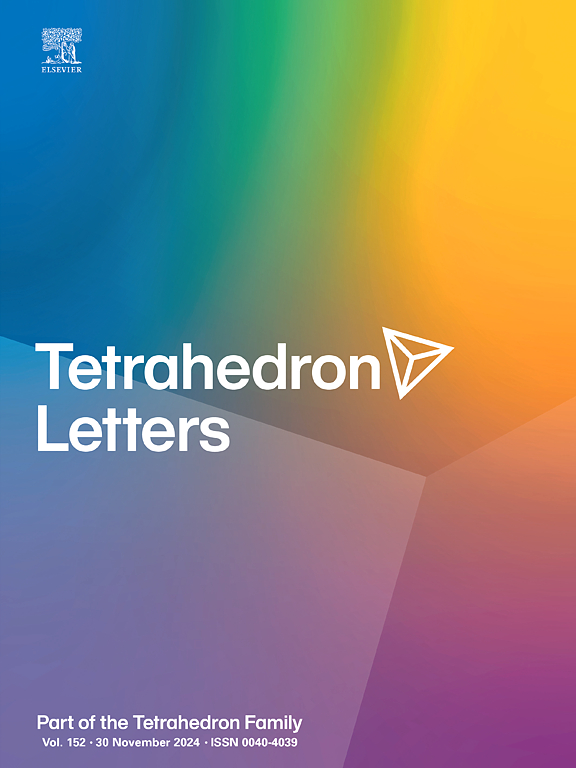螯合5 ' -(对羟基苯基)吡啶基噻唑作为d10金属离子的比例荧光探针
IF 1.5
4区 化学
Q3 CHEMISTRY, ORGANIC
引用次数: 0
摘要
合成了3种4′位置有不同螯合基团的5′-(对羟基苯基)吡啶基噻唑(HPPT),并通过荧光强度和分子内电荷转移(ICT)的变化,评价了它们在乙腈和水溶液缓冲液中检测过渡金属离子的能力。4′- o-吡啶氧基- hppt (Pic-HPPT)和4′- o- (o-羧基)- hppt (cpc - hppt)对CH3CN中的Zn(II)、Cd(II)和Pb(II)有较强的响应,发射色移可达68 nm,而4′- o-羧基甲基- hppt (CM-HPPT)无响应。在磷酸盐缓冲水溶液(PBS, pH 7.4)中,只有CPic-HPPT对d10金属离子有反应,这是由于邻羧酸盐增加了螯合能力。CPic-HPPT在CH3CN中与Zn(II)形成2:1的配合物,与Cd(II)和Pb(II)形成1:1的配合物,而在PBS中与Zn(II)、Cd(II)和Hg(II)离子形成1:1的配合物。对1:1 pic - hpt -金属离子配合物的x射线结构分析表明,配合物与Zn(II)呈平面三叉戟结合基序,而与较大的Cd(II)离子呈非平面三叉戟结合基序。用Zn(NO3)2在PBS中荧光滴定cpc - hppt,建立了亚微摩尔灵敏度,定量限为50 nM。这些结果表明,CPic-HPPT有望作为生理相关介质中d10金属离子的荧光探针。本文章由计算机程序翻译,如有差异,请以英文原文为准。

Chelating 5′-(p-hydroxyphenyl)pyridylthiazoles as ratiometric fluorescence probes for d10 metal ions
Three fluorescent 5′-(p-hydroxyphenyl)pyridylthiazoles (HPPT) with different chelating groups at the 4′ position were synthesized and evaluated for their ability to detect transition metal ions in acetonitrile and aqueous buffers, based on changes in fluorescence intensity and intramolecular charge transfer (ICT). Both 4’-O-picolyloxy-HPPT (Pic-HPPT) and 4’-O-(o-carboxypicolyl)-HPPT (CPic-HPPT) respond strongly to Zn(II), Cd(II), and Pb(II) in CH3CN with a bathochromic shift in emission up to 68 nm, whereas 4’-O-carboxymethyl-HPPT (CM-HPPT) is unresponsive. Only CPic-HPPT responds to d10 metal ions in aqueous phosphate buffered solution (PBS, pH 7.4), attributable to the added chelating power of the ortho-carboxylate. CPic-HPPT forms a 2:1 complex with Zn(II) and a 1:1 complex with Cd(II) and Pb(II) in CH3CN, whereas a 1:1 complex forms with Zn(II), Cd(II), and Hg(II) ions in PBS. X-ray structural analysis of 1:1 Pic-HPPT–metal ion complexes reveals a planar tridentate binding motif with Zn(II) but a nonplanar tridentate geometry with the larger Cd(II) ion. Fluorescence titration of CPic-HPPT in PBS with Zn(NO3)2 established sub-micromolar sensitivity with a limit of quantitation at 50 nM. These results show that CPic-HPPT has promise as a fluorescent probe for d10 metal ions in physiologically relevant media.
求助全文
通过发布文献求助,成功后即可免费获取论文全文。
去求助
来源期刊

Tetrahedron Letters
化学-有机化学
CiteScore
3.50
自引率
5.60%
发文量
521
审稿时长
28 days
期刊介绍:
Tetrahedron Letters provides maximum dissemination of outstanding developments in organic chemistry. The journal is published weekly and covers developments in techniques, structures, methods and conclusions in experimental and theoretical organic chemistry. Rapid publication of timely and significant research results enables researchers from all over the world to transmit quickly their new contributions to large, international audiences.
 求助内容:
求助内容: 应助结果提醒方式:
应助结果提醒方式:


